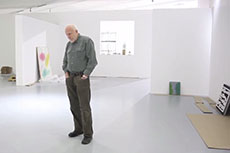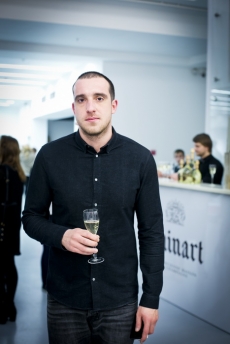The Continuity of Change













Igor Chelkovski. From the series "Architecture and color masses". 2007. Paint on wood. Artist’s collection
Igor Chelkovski. From the series "Architecture and color masses". 2007. Paint on wood. Artist’s collection
Igor Chelkovski. Construction. 1973. Paint on wood. Collection of Alexander Sidorov
Igor Chelkovski. Urban Structures. 2008. Paint on wood. Artist’s collection
Igor Chelkovski. Tall Buildings. 2008. Paint on wood. Artist’s collection
Igor Chelkovski. From the series "Sayings". 2001. Paint on wood. Artist’s collection
Igor Chelkovski. Cloud III. 2005. Paint on wood. Artist’s collection
Moscow, 30.11.2013—9.02.2014
exhibition is over
Share with friends
For the press
The theme of the city has become a living, all-embracing metaphor in Shelkovsky’s work: the demonstration of a consistent accumulation year after year of his own creative tasks in a growing ensemble of artistic practices. Or in other words, a world of plastic microsystems that comprise a multidimensional polysystem: a world of diverse exhibitions forming a universe of plurilingualism; a world of various techniques, images, rhythms, tonal contrasts and chromatic concords; a world of never-ending dialogue where painting speaks with the intonations of sculpture and sculpture is expressed by painting. In each instance the words accumulation, formation, co-ordination, concord, correlation and complementarity should be used in a musical rather than mechanical sense. Here there is another possible orientation point from analogous cues — the visual musicality of Walter Ruttmann’s film ‘Berlin: Die Sinfonie der Großstadt’ (‘Berlin: Symphony of a Metropolis’).
These can be enumerated as: landscapes, architecture, human figures, heads, faces, flags, blades of grass, trees, animals, clouds, proverbs, bouquets in vases and finally, just compositions. Essentially Shelkovsky’s City bears a similarity to the artist’s own studios in Élancourt and Moscow.
The first studio where Shelkovsky worked after returning to his native land was situated on the top floor of a nine-storey building with a panoramic view of Moscow. Naturally this led to the appearance of elongated images, the serrated silhouettes of an urban landscape: high-rise blocks, industrial structures, smoking chimneys and the clouds above... The artist assigns them the role of horizon in his exhibits.
Any ‘city as such’ is an imagined city. We cannot fully visualise a city. Each time we are confronted only by vistas, sketches, projects, plans, pictures, photographs, points of view or fragments. Shelkovsky’s City is a complex multiformity: the rhythm of heterogeneous spaces, volumes, plastic and chromatic surfaces and the living energies of poetic transformations.
Next to the reliefs hung on walls there are always sculptures. Towers, vegetation or city dwellers. Shelkovsky presents the City’s inhabitants as a component in a single semiotic system, translated into the constructive graphic language of the symbol. Shelkovsky’s City is a city of symbols. The symbols of the artist. Hence the monuments are not heroes, not ‘The Burghers of Calais’, but genre figures in an urban scene, ‘people walking’, ‘people sitting’, ‘people standing’: ‘Sportsman’, ‘Sitting Man’, ‘Striding Man’, ‘Sitting Man with Burden’, ‘Refectory’ (two figures at a table), ‘Two People with a Dog’, ‘Women in Long Dress’, ‘Woman in White’, ‘Woman in Full Height’, ‘Special Forces Soldier’, etc. Each figure, even with precise visual characteristics, is an ideogram, i.e. a symbol that conditionally portrays a concept while at the same time representing a ‘gallery of images’. Some of them, ‘tin people’, are figures comprised of the simplest elements, devoid of individual and gender characteristics, ‘people in general’. Others are like anthropomorphic reinterpretations of the latticed white cube modules of Sol LeWitt: the forms of human figures transparent to the onlooker. Some are impassively monolithic, while others beyond the logic of cubic schematics are emotionally charged, expressive, or ‘portrait-like’. An example is provided by the graphically contoured three-dimensional heads in the ‘Metro’ series: masterfully depicted mesh profiles of passengers trapped in the crush.
The creative power of the transformations is revealed with expressive clarity in Shelkovsky’s graphic laboratory. Here the scope of the metamorphoses is extraordinarily wide-ranging. Plein-air landscapes and still life with Indian ink, ‘Matisse-like’ nudes sketched by continuous-line drawing, detailed linocut landscapes, finely drawn linear portraits with a carpet of flowers in the background, stippled heads...
Like all Shelkovsky’s series, cycles and exhibitions — about Reality. Reality in the experience of the artist, the reality of his work in the vanishing reality of art. About the reality of art in the vanishing reality of life. About the reality of life at the boundaries of doubt and belief. About reality that is not illusory, but poeticised, each time revealed anew by the artist and recreated again by the trusting recognition of the observer. A reality encountered beyond the threshold of what we are accustomed to, by the revelation of veracity.
Text printed abbreviated.
Evgeny Barabanov
























